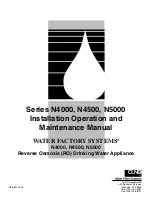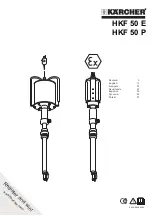
© 2011
D 315 - 04/11
6 of 12
Testing the Control Wiring
Testing the Power
-----------------------------
-----------------------------
If the control Power light does not turn on, check the Input
Power wiring terminals using an electrical multimeter. The
voltage should measure between 21.6 to 26.4 V (ac). If the
voltage is below this range, measure the line voltage side
of the transformer. The voltage should measure between
103.5 to 126.5 V (ac).
Testing tekmarNet
®
4 Thermostats
------------
------------
1. To test the tN4 Network, check the tN4 and C wires for
continuity.
Disconnect the tN4 and C wires from the tekmarNet
®
4
Wiring Center and twist them together.
Go to the thermostat and disconnect the tN4 and C
wires.
Using an electrical test meter, check for continuity.
If continuity exists, then proceed to next step, if not,
verify that correct wires are in place prior to continu-
ing to next step.
Reconnect the wires to the proper terminals.
2. To test the call for Heat (W), a continuity test is used
between terminals R and W.
Disconnect the wire from terminal W on the 315.
When the thermostat calls for heat, the resistance be-
tween R and the disconnected W wire should be 0
ohms or tone indicating continuity.
When there is no call for heat the resistance be-
tween R and W should be infinite, O.L. or no tone
should be heard.
Testing Conventional Thermostats
------------
------------
To test the call for Heat (W), a continuity test is used
between terminals R and W.
1. Disconnect the wire from terminal W.
2. When the thermostat calls for heat, the resistance
between R and the disconnected W wire should be
less than 7 ohms or tone indicating continuity.
3. When there is no call for heat the resistance between
R and the disconnected W wire should be infinite, O.L.,
or no tone should be heard.
Testing Power-Stealing Thermostats
----------
----------
The tN4 Wiring Center 315 can also accept ‘power-stealing’
type thermostats. They must output less than 5 V (ac) when
not calling for heat, or the 315 may detect a false heat call
and open the corresponding zone valve.
1. Connect the R & W wires from the thermostat to the
desired zone R and W terminals on the 315.
2. When the thermostat is not calling for heat, the
corresponding zone LED should not be lit.
If the zone LED is lit, then a resistor may have to be
added to reduce the trickle voltage through the ther-
mostat. See the thermostat installation manual for
details.
•
•
•
•
•
•
•
•
Testing the Zone Output
----------------------
----------------------
1. Use an electrical test meter to measure the (ac) voltage
between the C and the Vlv terminals for each zone valve
output.
Lower the thermostat temperature setting. When the
zone LED is off, the reading should be 0 V (ac) and the
valve should be closed.
Raise the thermostat temperature setting. When the
zone LED is on, the reading should be 24 V (ac) + / –
10% and the valve should be open.
Note:
If power to the zone valve is present but the zone
valve does not operate properly, refer to any troubleshooting
information supplied by the zone valve manufacturer.
Testing tekmarNet
®
4 Expansion
--------------
--------------
To test the tN4 Network, check the wires for continuity
and shorts.
1. Disconnect the two tN4 expansion wires (tN4 and C)
at one end and twist them together.
2. Go to the other end of the wires and disconnect
them.
3. Using an electrical test meter, check for continuity.
Resistance should read 0 ohms, or continuity should
produce a tone. If not, this indicates that there are
damaged wires connecting the tN4 control to the 315.
Repair or replace them as necessary.
4. Go back to the original end of the wires and, using a
wire nut, cap each expansion wire individually so that
these ends cannot touch another conductor.
5. Go to the other end of the wires and again, test for
shorts. Resistance should be infinite, or O.L. and there
should be no tone. If tone exists or less than 50 000
ohms is found, then the wires are not insulated from
one another. This is generating a short on the wires
connecting the tN4 control to the tN4 Wiring Center.
6. Replace the damaged wires, test, and reconnect them
to their proper terminals.
Testing The End Switch / Zone Group Pump
--
--
If the tN4 expansion terminals are not used to connect
the tN4 Wiring Center to the system, the end switch may
be used.
1. Remove the wires from the end switch terminals.
2. Use an electrical test meter to measure continuity
across the XX end switch terminals on the 315.
When the end switch LED is off, no continuity should
be present (no tone).
When the end switch LED is on, continuity should be
present (tone).
3. Use an electrical test meter to measure voltage across
the zone group pump hot switch leg and neutral.
When the zone group pump LED is off, the voltage
should be 0 V (ac).
When teh zone group pump LED is on, the voltage
should be between 103.5 to 126.5 V (ac).
•
•
•
•
•
•






























